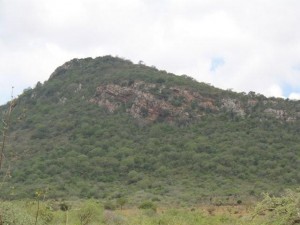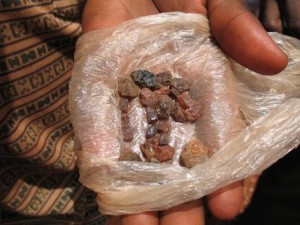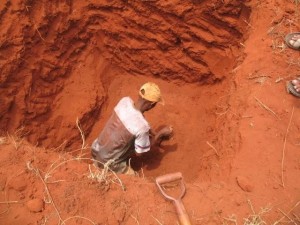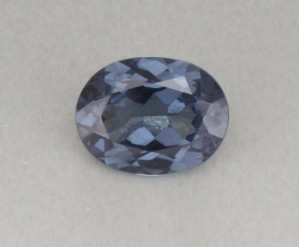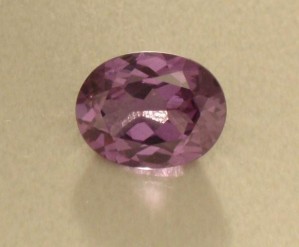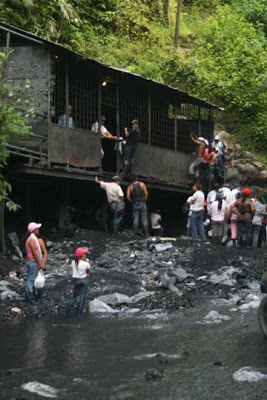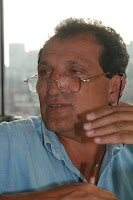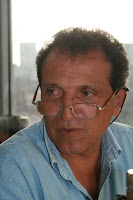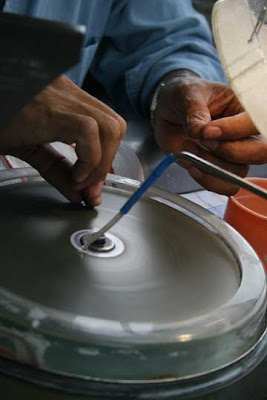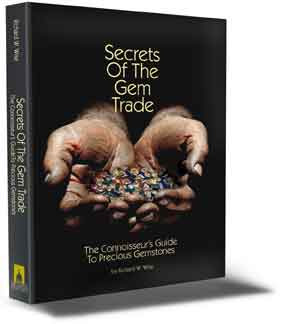Drama In The Desert: ISG Seminar–A Dry Hole:
by Richard W. Wise, G.G. © 2009
The much ballyhooed "Epochal Crisis" never quite materialized at the International School of Gemology's "Let the Science Speak" seminar held February 6th at the Arizona Hotel. In a rambling presentation, ISG President Robert James back-pedaled on some of his previous statements and presented the results of advanced tests that contradicted his own theories.
The silence was eerie. It was painful to watch. Thanks to Colored Stone Magazine's drum beating, the talk was attended by a who's who of gem scientists. James' attempts at folksy humor fell flat. The scientists sat quietly and listened to the presentation of evidence. After the presentation, they politely applauded, asked few questions and filed out, leaving Robert James' reputation as a gemologist in a heap of smoldering ruins.
In a series of internet broadsides last September, James made sweeping claims that large amounts of Mozambique cuprian, as well as other tourmaline, were being subjected to copper diffusion treatment. Recently he cast his net wider, suggesting that what he now calls Grain Boundary Diffusion, is being used to improve the color of not only tourmaline, but garnet and topaz as well.
Goop In The Tubes:
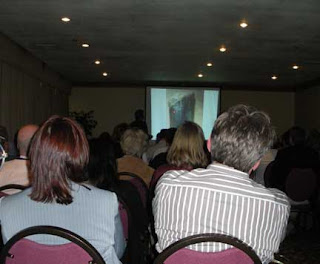
The presentation centered on what James called "crud in the tubes." Hollow growth tubes are a characteristic tourmaline inclusion. What James finds telling is the fact that in some Mozambique tourmaline, these tubes are filled with a yellow-red substance that James cannot identify. In a previous GemWise blog, serious questions concerning these claims were raised by John Koivula and Christopher Smith, questions that James failed to address. In a significant variation on last September's theme, James has now backed away from his claim that the filling material is copper. In fact, he carefully avoided using the term copper diffusion throughout the lengthy talk.
James showed slides showing what he calls diagnostic "footprints" which prove treatment. However the footprints he finds in topaz do not in the least resemble the "footprints" he finds in tourmaline. His tourmaline slides showed straight growth tubes; his topaz slides showed a spider web of tiny lines. He presented absolutely no proof of diffusion in tsavorite garnet; he simply suggested that the appearance, in the past decade, of tsavorite over two carats is ominous. He never explains how that relates to his diffusion theory. Last September, he claimed he discovered that undisclosed amounts of synthetic tourmaline were being sold, but now admits tha t he was wrong. (image right: large chunks of tsavorite rough from a 2007 strike at the Scorpion Mine, Voi, Kenya, that yielded several stones above 10 carats. Courtesy: Tsavorite USA)
t he was wrong. (image right: large chunks of tsavorite rough from a 2007 strike at the Scorpion Mine, Voi, Kenya, that yielded several stones above 10 carats. Courtesy: Tsavorite USA)
The conclusions drawn from the advanced testing promised last September conclusively demonstrated that James understands neither the characteristics of his test material, nor the diffusion process itself. According to James, LA-ICP-MS testing (commonly called laser ablation) conducted by Evans Analytical showed differing concentrations of manganese and iron in the tourmaline samples tested, with higher concentrations toward the center of the specimens. James suggests that this is another "footprint" left b y the treatment process, and fails to note that the characteristic color zoning in tourmaline is the result of compositional differences within the stone. For example, higher concentrations of manganese produce richer pink zones in tourmaline.
y the treatment process, and fails to note that the characteristic color zoning in tourmaline is the result of compositional differences within the stone. For example, higher concentrations of manganese produce richer pink zones in tourmaline.
In a later Q&A session, when the soft-spoken Dr. Adolf Peretti, former head of the Gueblin Lab and President of the GRS Lab in Bangkok, told him flat out that varying concentrations of elements are characteristic of natural tourmaline, James suggested that Peretti's test samples had been altered by diffusion. (photo left: Gemology 101, a natural "footprint" crystal cross-section: pink color zone caused by concentrations of Mg. in the center of the crystal. Similar images exist in the literature going back 150 years)
How Diffusion Works:
Diffusion is the word currently bandied about, but what is it, what does the term mean? Let me share with you an analogy suggested to me by one of the world's leading authorities on the use of diffusion treatment in gemstones:
Consider a dollop of blue ink dropped into a glass of water. The ink will slowly diffuse throughout the water, eventually turning the water a uniform light blue. Ion diffusion, or deep diffusion, works exactly the same way. Diffusion moves from higher to lower concentrations. Just as the ink does not remain concentrated, outside substances such as Beryllium and copper, when introduced into gem material, spread out and diffuse throughout the material. The ions do not concentrate as James suggests–concentration is the result of slow natural crystal growth and results in zones of color, a common trait in tourmaline. Thus, James' advanced testing proves, as Dr. Piretti and Dr. Kiefert have pointed out, exactly the opposite of James' contention. Concentrations of manganese and iron in tourmaline prove that the color is natural.
Industry writer and James acolyte David Federman has been warning for months that James' presentation would spark what he terms as an "epochal crisis" in the gem trade. Abandoning any pretense of objective journalism, he has written three articles praising James and ignoring prominent scientists such as John Kiovula, Richard Hughes, Christopher Smith and Ted Themelis who profoundly disagree with James' methods and conclusions. In the current Colored Stone, Federman says we are living in "gemological end-times." What did all this apocalyptic rhetoric amount to? What James actually presented was mostly old, largely discredited information that although full of sound and fury, flies in the face of science and logic and proves his own theory to be totally false.
AGTA and GJX:
There was definitely more action at the gem shows, but then gems are the major reason most people are here in Tucson during this two-week period. Most dealers I interviewed said that sales exceeded their expectations, though they didn't say what those expectations were. All signs point to a tough year ahead. As dealer Chris Johnston pointed out, its a Darwinian crisis, and as usual, the strong will survive.
Visit Burma's Valley of the Serpents and learn how sapphire is mined and graded. Follow me on gem buying adventures in Burma, Thailand and Sri lanka. Visit the gem fields of Australia and Brazil. 120 carefully select ed photographs showing examples of the highest quality gems to educate the eye, including the Rockefeller Sapphire and many more of the world's most famous gems. Consider my book: Secrets Of The Gem Trade, The Connoisseur's Guide To Precious Gemstones.
ed photographs showing examples of the highest quality gems to educate the eye, including the Rockefeller Sapphire and many more of the world's most famous gems. Consider my book: Secrets Of The Gem Trade, The Connoisseur's Guide To Precious Gemstones.
“Wise is a renowned author… He’s done a marvelous job of this first book, monumental work, a tour de force…My recommendation: Buy this book”.
Charles Lewton-Brain, Orchid
whether you like to know what the best colour is in Tanzanite, or how to grade a Diamond, you will find it in this book. No other book I read before dealt with this topic is such detail as Richard Wise's masterpiece."
A. Van Acker, FGA Amazon June 2005
"Secrets Of The Gem Trade: The Connoisseurs Guide To Precious Gemstones by Richard W. Wise is an impressive new reference for dedicated dealers and collectors of gems, gemstones, and … pearls. Introducing and descriptively exploring each and every gem covered in the easy-to-use reference, Secrets Of The Gem Trade contains an illustrated summary of each stone inclusive of its history and general information, hue and tone, saturation, which may be noticed as the finest, an understanding of the particular gems rarity, and the caution for synthetics and how to depict them, however depending upon the stone there may be description of clarity, color fading, multi-color effect, etc. Secrets Of The Gem Trade is very highly recommended to anyone interested in gemology as a superbly organized, authoritative, comprehensive, and easy-to-follow reference."
Midwest Book Review April 2006
Only $39.95 in paperback. Read a couple of chapters online an order: We recently discovered about a dozen copies of the out of print hardcover: $79.95 signed by the author www.secretsofthegemtrade.com.
Buy it on Amazon: www.amazon.com
